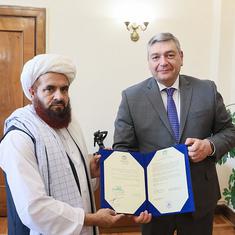In 1881, Maharaja Chamaraja Wadiyar X ascended the Mysore “gaddi” five decades after the British had annexed the kingdom from his ancestors. To reassert his sovereignty over Mysore, he sought the power of a benediction on the occasion of his coronation. Thus was born the Mysore anthem, Kayau Shri Gowri (God Protect the King).
Wadiyar’s court poet Basavappa Shastry wrote an austere Kannada poem to which Carnatic veena maestro Veene Vankatagiriyappa and bandmaster Bartels added a majestic tune in Western Ionian mode, equivalent to the Carnatic raag Shankarabharana.
Battered by battle and several travails of power, Mysore found a new stirring loyalty to the crown in an anthem with three stanzas and a refrain. A new identity for Mysore beckoned.
Kayau Shri Gowri Karunalahar
Thoyajakshi Shankarishwari
Great Gowri, thou lotus-eyed goddess benign
Pour forth on our raja thy blessings divine
Shri Jayachamundike Shrijayachamendra
Namankita Bhoomendra Lalamana Mudade
O Chamundi, dark visaged lady divine,
Watch over thy namesake of Chamendra’s line.
The song enlisted divine grace – in this case of the mother goddess Gauri – to protect the king. In many ways, the song echoed the spirit of the British anthem, which once resounded in all of its colonies, paradoxically singing the glory of the “commonwealth”, as its impoverished colonies wailed in this pageantry.
God Save the King had been sung for the first time in public on September 28, 1745, at the Theatre Royal in London, as news reached the city that Prince Charles Edward Stuart’s army had defeated the troops of King George II. For George, the only artillery remaining was music. The band at the theatre invoked a poem dating back to the early seventeenth century. The performance stirred national sentiments, invoking loyalty to the crown, resilience amidst threat.
God save our gracious king!
Long live our noble king!
God save the king!
Send him victorious,
Happy and glorious,
Long to reign over us;
God save the king!
Even as the Mysore anthem, like the British one, implores divine intercession to ensure a long reign by the monarch, the crowning melody line of Kayau Shri Gowri actually contained the first counterpoint of democracy in Mysore.
Soon after his coronation and in contrast to the monarchy-glorifying anthem, Chamaraja Wadiyar made a startling proclamation on August 25, 1881. He was going to install a democratic apparatus for Mysore, much to the surprise of other princely kingdoms.
This development was viewed with great curiosity across India. With the legislature and constitution, Mysore grew into a model princely kingdom. Remarked the nationalist weekly, The Mahratta, “The British government might do well to take a lesson from the enlightened Maharaja of Mysore.”
In 1940, when Chamaraja Wadiyar’s grandson Jayachamaraja Wadiyar, a 20-year old pianist and bibliophile ascended the throne, one of his first acts was to expand the powers of his legislature and bring in free speech in its deliberations.
He also envisioned a cabinet of ministers with specific portfolios and departments they were to serve. An archive of material – the Mysore Administrative Reports, the Bulletins, the Blue Books – gives a sense of the workings of a well-functioning constitutional monarchy.
Independence beckons
Even as thousands of his subjects prayed to Chamundi, the personal deity of the Wadiyar clan, to watch over the Chamaraja’s line, a new polity emerged after India’s independence. As the Constitution for India was being crafted, the coda became clear. He was to be the last Maharaja of Mysore.
With Independence imminent, he signed the instrument of accession to India on August 6, 1947. On November 25, 1949, Jayachamaraja Wadiyar issued a proclamation ordering that the Constitution framed by India’s Constituent Assembly would be applicable to Mysore too. Three weeks later, the Mysore Representative Assembly and the Legislative Council was dissolved.
In 1956, replying to a speech made by Chief Minister Kengal Hanumanthiah, on his 37th birthday, Jayachamaraja Wadiyar noted: “‘You have referred in your address to what your generosity has termed my ‘sacrifice’. I do not look upon it as such. If destiny had decreed that over the past few centuries the progress and the prosperity of the people of this beloved state, should be in the hands of the Wadiyars of Mysore, then that same destiny now ordains that the time is ripe for the people, now grown to full political stature in a free democratic Republic, to rule themselves ...the rule of the Maharajas has indeed fulfilled its purpose, the purpose of making the people fit to rule themselves.”
The Mysore anthem had outlived its purpose.
Today, as the British national anthem solicits allegiance to the crown, the Mysore anthem invokes loyalties of a different kind – one that is not bound by boundaries of time and space. It is, instead, an anthem to the Mysorean spirit.
*Translations by Rajachandra, son-in-law of Jayachamaraja Wadiyar.
Dr Deepti Navaratna is a musician and neuroscientist who loves creative voyages through history via song. Her work can be seen on her website here.
Also read
How the Maharaja of Mysore ended up fulfilling the last wish of composer Richard Strauss










